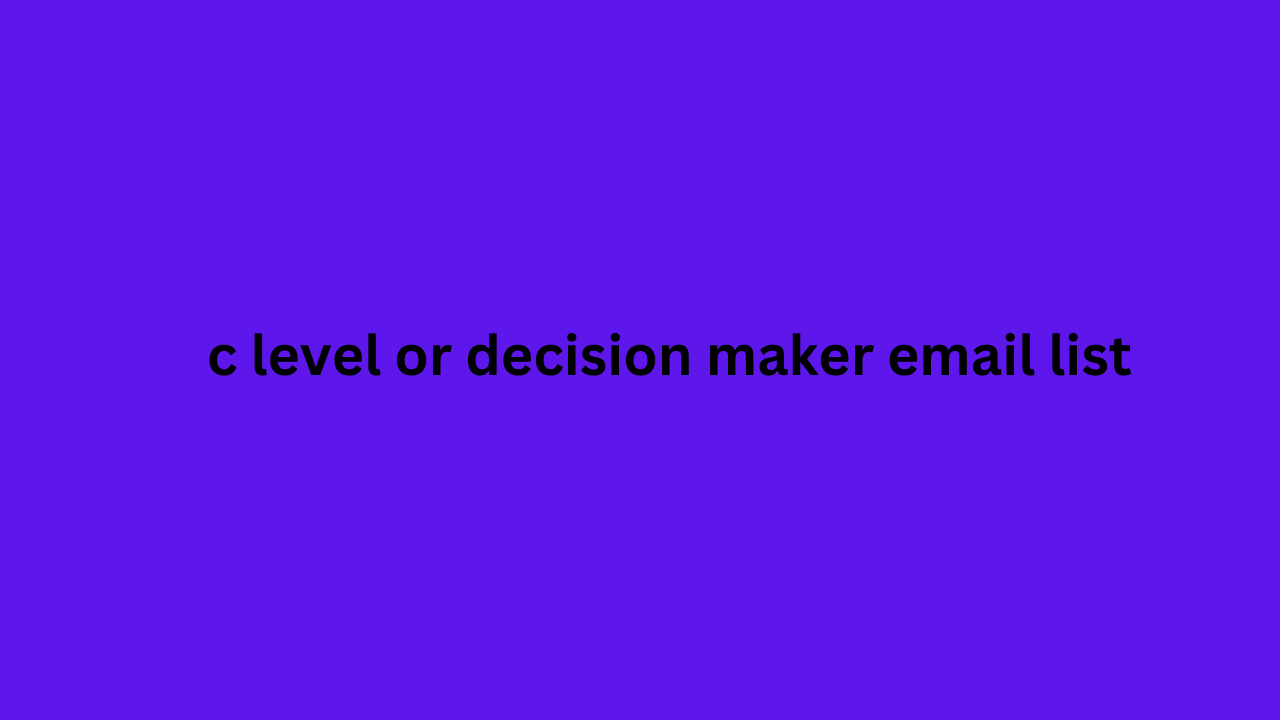13 Sales Metrics Every Sales Manager Should Monitor
Posted: Tue Dec 17, 2024 4:24 am
“What is not measured is not known, what is not known is not managed, what is not managed is not improved” dictate the principles of classical management. Without a doubt, metrics are a necessity and, in many cases, a major problem when managing a sales or commercial department . But that doesn’t have to be the case in your case. Below you will find a series of key indicators that will help you measure the progress of your activities.
Before getting into the subject, let's develop some basic terms for optimal management.
What is a KPI
They are qualitative and quantitative indicators that help you monitor the c level or decision maker email list fulfillment of objectives within a department or organization. Through KPIs you can know if your actions are yielding results and help you make decisions based on certain facts.

KPIs (Key Performance Indicators ) help measure the performance of a process. For example, a correct selection of KPIs in online marketing or digital marketing allows us to know if our marketing campaigns and actions (for example, certain social media actions or a social media campaign ) are working. Similarly, key performance indicators for commercial actions allow us to monitor the fulfillment of the objectives set in sales, customer loyalty, number of visits, etc.
KPI - Key Performance Indicator- Word Drawn on Old Poster. Business Concept in Flat Design.
Types of KPI
There are different types of indicators that, depending on the management , will help you optimize and reduce the waste of resources. Here are some of them:
Retail KPIs
Footfall or number of visits
Frequency of visits
Hours with the highest traffic
Sales
Sales per visit
Sales per square meter
Units sold per transaction
Net margin
Conversion rate
Sales by category
Conversion rate by category
Average ticket
Stock rotation
Sell Through Ratio (inventory sold)
Loyalty
Returns.
Logistics KPIs
Raw material inventory turnover
Raw material stockout
Product inventory turnover
Product out of stock
Average cost per purchase order for raw materials
Supply period (Lead Time)
Margin between raw material cost and total sales
Average payment period
Compliance with deadlines
Billing errors
Average unit transport cost
Transport cost on sales
Cost per kilometer
On-time deliveries.
Sales KPIs
Billing level
Average profitability of sales
Profitability and margin of each product
Market share
Market positioning
Stock rotation
Loyalty index
Claims
Returns
Customer visits
Phone calls
Client visits or meetings
Purchase volume per customer
New vs. returning customers
Conversion ratios
Cost per conversion
KPIs finance
Profit margin
Cost efficiency
ROI (Return on Investment)
ROCE (Return on capital employed)
Effective conversion cycle
Sustainable growth
Degree of liquidity
Sales Force Performance
Cost reduction index
Profitability
Cash flow
Coverage ratio
Self-financing ratio
Autonomy ratio
Solvency
Financial leverage.
Social media KPIs
Increase in followers
Scope
Engagement
CTR ( Click Through Rate)
CPL ( Cost per Lead)
Conversion
ROI (Return on Investment).
Now, okay. If what you want to measure is how productive your marketing/sales employees are, then keep reading.
Before getting into the subject, let's develop some basic terms for optimal management.
What is a KPI
They are qualitative and quantitative indicators that help you monitor the c level or decision maker email list fulfillment of objectives within a department or organization. Through KPIs you can know if your actions are yielding results and help you make decisions based on certain facts.

KPIs (Key Performance Indicators ) help measure the performance of a process. For example, a correct selection of KPIs in online marketing or digital marketing allows us to know if our marketing campaigns and actions (for example, certain social media actions or a social media campaign ) are working. Similarly, key performance indicators for commercial actions allow us to monitor the fulfillment of the objectives set in sales, customer loyalty, number of visits, etc.
KPI - Key Performance Indicator- Word Drawn on Old Poster. Business Concept in Flat Design.
Types of KPI
There are different types of indicators that, depending on the management , will help you optimize and reduce the waste of resources. Here are some of them:
Retail KPIs
Footfall or number of visits
Frequency of visits
Hours with the highest traffic
Sales
Sales per visit
Sales per square meter
Units sold per transaction
Net margin
Conversion rate
Sales by category
Conversion rate by category
Average ticket
Stock rotation
Sell Through Ratio (inventory sold)
Loyalty
Returns.
Logistics KPIs
Raw material inventory turnover
Raw material stockout
Product inventory turnover
Product out of stock
Average cost per purchase order for raw materials
Supply period (Lead Time)
Margin between raw material cost and total sales
Average payment period
Compliance with deadlines
Billing errors
Average unit transport cost
Transport cost on sales
Cost per kilometer
On-time deliveries.
Sales KPIs
Billing level
Average profitability of sales
Profitability and margin of each product
Market share
Market positioning
Stock rotation
Loyalty index
Claims
Returns
Customer visits
Phone calls
Client visits or meetings
Purchase volume per customer
New vs. returning customers
Conversion ratios
Cost per conversion
KPIs finance
Profit margin
Cost efficiency
ROI (Return on Investment)
ROCE (Return on capital employed)
Effective conversion cycle
Sustainable growth
Degree of liquidity
Sales Force Performance
Cost reduction index
Profitability
Cash flow
Coverage ratio
Self-financing ratio
Autonomy ratio
Solvency
Financial leverage.
Social media KPIs
Increase in followers
Scope
Engagement
CTR ( Click Through Rate)
CPL ( Cost per Lead)
Conversion
ROI (Return on Investment).
Now, okay. If what you want to measure is how productive your marketing/sales employees are, then keep reading.